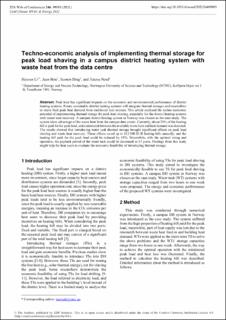| dc.contributor.author | Li, Haoran | |
| dc.contributor.author | Hou, Juan | |
| dc.contributor.author | Ding, Yuemin | |
| dc.contributor.author | Nord, Natasa | |
| dc.date.accessioned | 2021-10-21T08:36:38Z | |
| dc.date.available | 2021-10-21T08:36:38Z | |
| dc.date.created | 2021-05-06T10:37:40Z | |
| dc.date.issued | 2021 | |
| dc.identifier.issn | 2267-1242 | |
| dc.identifier.uri | https://hdl.handle.net/11250/2824398 | |
| dc.description.abstract | Peak load has significant impacts on the economic and environmental performance of district heating systems. Future sustainable district heating systems will integrate thermal storages and renewables to shave their peak heat demand from traditional heat sources. This article analysed the techno-economic potential of implementing thermal storage for peak load shaving, especially for the district heating systems with waste heat recovery. A campus district heating system in Norway was chosen as the case study. The system takes advantage of the waste heat from the campus data centre. Currently, about 20% of the heating bill is paid for the peak load, and a mismatch between the available waste heat and heat demand was detected. The results showed that introducing water tank thermal storage brought significant effects on peak load shaving and waste heat recovery. Those effects saved up to 112 000 EUR heating bills annually, and the heating bill paid for the peak load could be reduced by 15%. Meanwhile, with the optimal sizing and operation, the payback period of the water tank could be decreased to 13 years. Findings from this study might help the heat users to evaluate the economic feasibility of introducing thermal storage. | en_US |
| dc.language.iso | eng | en_US |
| dc.publisher | EDP Open | en_US |
| dc.rights | Navngivelse 4.0 Internasjonal | * |
| dc.rights.uri | http://creativecommons.org/licenses/by/4.0/deed.no | * |
| dc.title | Techno-economic analysis of implementing thermal storage for peak load shaving in a campus district heating system with waste heat from the data centre | en_US |
| dc.type | Peer reviewed | en_US |
| dc.type | Journal article | en_US |
| dc.description.version | publishedVersion | en_US |
| dc.source.volume | 246 | en_US |
| dc.source.journal | E3S Web of Conferences | en_US |
| dc.identifier.doi | https://doi.org/10.1051/e3sconf/202124609003 | |
| dc.identifier.cristin | 1908394 | |
| dc.relation.project | Norges forskningsråd: 262707 | en_US |
| cristin.ispublished | true | |
| cristin.fulltext | postprint | |
| cristin.qualitycode | 1 | |

